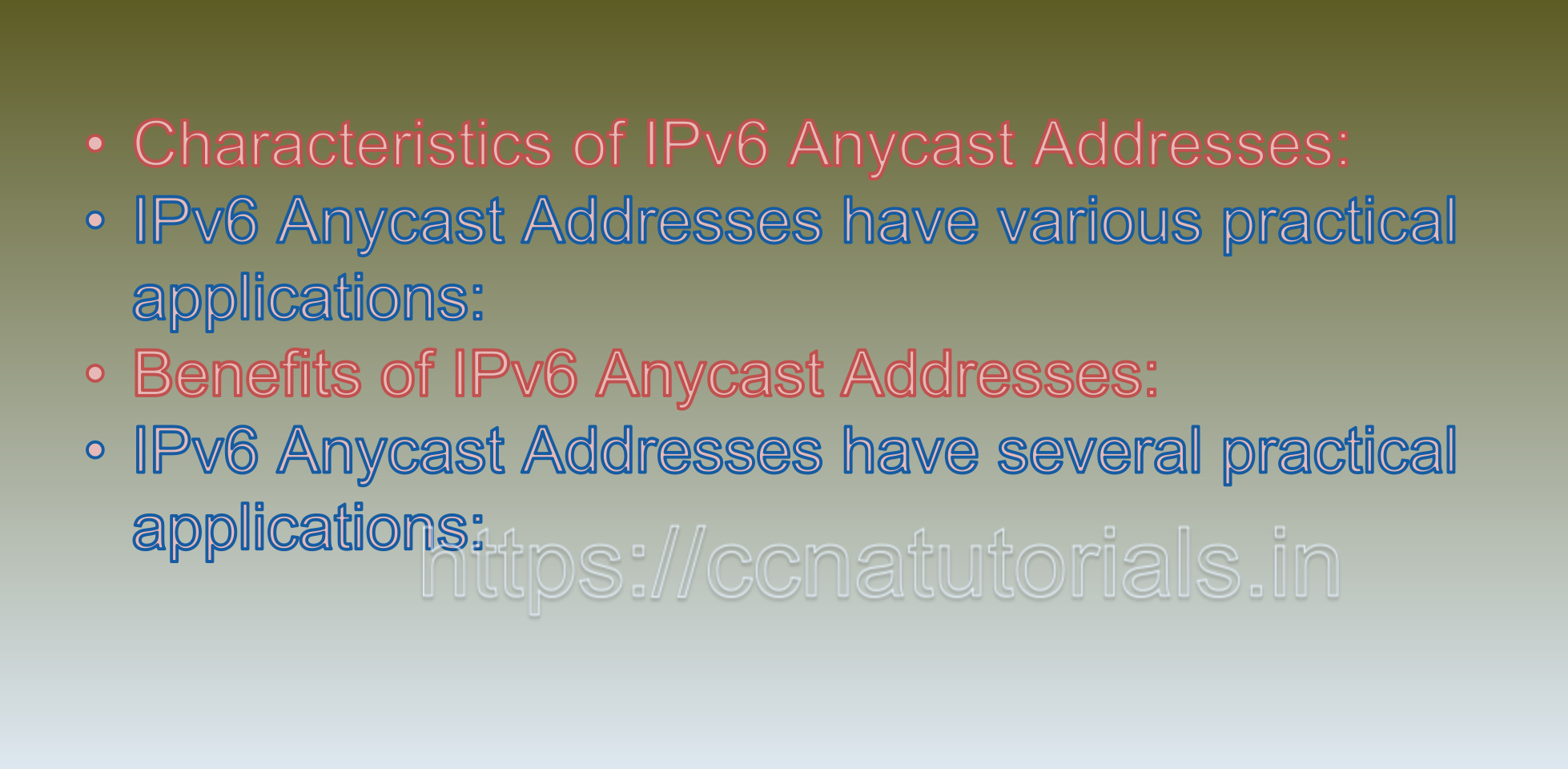Contents of this article
In this article, I describe IPv6 Anycast Addresses via different approaches. IPv6 Anycast Addresses are a special type of IPv6 address used to route packets to the nearest member of a group of devices that share the same anycast address. Unlike unicast addresses (one-to-one communication) or multicast addresses (one-to-many communication), anycast addresses facilitate one-to-nearest communication. In this guide, we’ll explore the concept of IPv6 Anycast Addresses, their characteristics, uses, and examples.
Characteristics of IPv6 Anycast Addresses:
1. Nearest Node Communication:
Anycast addresses allow packets to be sent to the nearest (topologically closest) member of a group of devices sharing the same anycast address.
2. Address Range:
Anycast addresses are derived from the unicast address space (`2000::/3`). They are typically assigned to a group of devices providing the same service, such as DNS servers or content delivery networks (CDNs).
3. Routing Mechanism:
The routing infrastructure ensures that packets are directed to the nearest member of the anycast group based on network topology and routing metrics.
4. Automatic Failover:
Anycast addresses inherently provide a form of automatic failover, as traffic is automatically rerouted to the next nearest member if one becomes unavailable.
5. Scope Identifier:
As with other IPv6 addresses, a scope identifier can be appended after the address, separated by a percent sign (%). For example: `2001:db8::1%eth0`.
Uses of IPv6 Anycast Addresses:
IPv6 Anycast Addresses have various practical applications:
1. DNS Services:
Anycast addresses are commonly used for DNS servers. Multiple DNS servers share the same anycast address, allowing clients to be directed to the nearest available DNS server for faster name resolution.
2. Content Delivery Networks (CDNs):
CDNs utilize anycast addresses to route clients to the nearest content server, reducing latency and improving content delivery.
3. Network Services:
Anycast can be employed for services like load balancers, ensuring incoming traffic is directed to the closest available server.
4. Distributed Applications:
Anycast can be used in distributed applications to direct traffic to the closest instance of the application for improved performance and resource utilization.
Example of IPv6 Anycast Address:
Assume you are setting up DNS servers with anycast addresses for improved name resolution. You choose the prefix `2001:0db8:1234::/48` for your DNS servers.
1. Unicast Address: Assign the unicast address `2001:0db8:1234:1::1` to one DNS server.
2. Anycast Address: Assign the anycast address `2001:0db8:1234:1::1` to multiple other DNS servers.
When a client queries for DNS resolution using the anycast address `2001:0db8:1234:1::1`, the routing infrastructure will direct the query to the nearest available DNS server based on network topology and routing metrics.
Scope Identifier: If the Anycast Address is assigned to the `eth0` interface, you can add a scope identifier as follows:
`2001:0db8:1234:1::1%eth0`
Conclusion for this portion related to IPv6 Anycast Addresses:
IPv6 Anycast Addresses provide a powerful mechanism for directing traffic to the nearest member of a group of devices sharing the same address. By understanding the characteristics and applications of Anycast Addresses, network administrators can implement efficient and robust network services, content delivery, and distributed applications that benefit from automatic failover and optimized routing to the nearest available resources.
IPv6 Anycast Addresses via another approach
IPv6 Anycast Addresses are a unique type of IPv6 address used to represent a group of devices that provide the same service or function. Anycast allows multiple devices to share the same IPv6 address, and when a packet is sent to that address, it is automatically routed to the nearest or best-performing device in the group. In this guide, we’ll explore the concept of IPv6 Anycast Addresses, their characteristics, uses, and examples.
Characteristics of IPv6 Anycast Addresses:
1. Shared Address:
Devices in an Anycast group share the same IPv6 address, allowing clients to send packets to that address without needing to know the specific device’s location.
2. Routing to Nearest Node:
When a packet is sent to an Anycast address, routers route it to the nearest available device in the Anycast group based on routing metrics like shortest path or lowest latency.
3. Dynamic Routing:
Anycast addresses leverage dynamic routing protocols to ensure that traffic is efficiently directed to the closest device in real-time, adapting to network changes.
4. No Special Address Range:
Unlike multicast addresses, Anycast addresses are typically assigned from the same IPv6 address range as unicast addresses. There is no dedicated Anycast address range.
Uses of IPv6 Anycast Addresses:
IPv6 Anycast Addresses have various practical uses:
1. Content Distribution Networks (CDNs):
CDNs use Anycast to distribute content to multiple servers located at different geographical locations. This minimizes latency and improves user experience.
2. Domain Name System (DNS):
Anycast is commonly used in DNS services to provide fast and reliable name resolution by directing client queries to the nearest DNS server.
3. Load Balancing:
Anycast is used for load balancing by distributing client requests to the closest server, optimizing resource utilization and response times.
4. Distributed Services:
Anycast can be used for any service that benefits from being replicated across multiple locations, such as distributed databases or distributed denial-of-service (DDoS) protection services.
Example of IPv6 Anycast Address:
Assume you have a group of DNS servers located around the world to provide fast and reliable name resolution for your organization’s domain. You want to use Anycast for your DNS service.
1. You assign an IPv6 address from your organization’s IPv6 address range to the DNS servers: `2001:0db8:1234::10`.
2. Configure your routers to announce the Anycast address (`2001:0db8:1234::10`) on multiple interfaces in different geographical locations.
3. When a client sends a DNS query to the Anycast address, routers route the query to the nearest DNS server in the group, ensuring low latency responses.
Conclusion for this portion related to IPv6 Anycast Addresses:
IPv6 Anycast Addresses provide an efficient and scalable way to distribute services across multiple devices and locations. By sharing the same address while dynamically routing traffic to the nearest available node, Anycast addresses enhance service performance, reliability, and availability. Understanding Anycast’s characteristics and use cases is crucial for architects and administrators designing and deploying distributed services on IPv6 networks.

IPv6 Anycast Addresses via different approach
IPv6 Anycast Addresses are a unique type of IPv6 address used for routing and directing network traffic to the nearest or most appropriate instance of a service or resource within a group of devices. Anycast allows multiple devices to share the same IPv6 address, and when a packet is sent to that address, it is automatically routed to the closest or best-performing instance of the service. In this guide, we’ll explore the concept of IPv6 Anycast Addresses, their characteristics, uses, and examples.
Characteristics of IPv6 Anycast Addresses:
1. Multiple Instances:
Anycast allows multiple devices (nodes) to share the same IPv6 address within a network. Each instance provides the same service or resource.
2. Routing to Nearest Node:
When a packet is sent to an Anycast address, it is routed to the nearest or best-performing node based on routing metrics such as shortest path or least delay.
3. Location-Based Routing:
Anycast leverages routing protocols to ensure that packets are delivered to the instance of the service that is topologically closest to the sender.
4. Dynamic Routing:
Anycast addresses are typically associated with routing protocols that ensure traffic is directed to the optimal node as network conditions change.
Uses of IPv6 Anycast Addresses:
IPv6 Anycast Addresses have several practical applications within networks:
1. Content Delivery Networks (CDNs):
CDNs use Anycast to distribute content to multiple edge servers. Users are directed to the nearest server, reducing latency and improving content delivery.
2. Domain Name System (DNS):
Anycast is used for DNS root servers and top-level domain servers to improve the efficiency and resilience of the DNS infrastructure.
3. Network Time Protocol (NTP):
Anycast is employed for NTP servers, allowing devices to synchronize time with the closest and most accurate time source.
4. Load Balancing:
Anycast can be used for load balancing across multiple data centers or server instances, distributing client requests to the optimal location.
Example of IPv6 Anycast Address:
Assume you have a network with multiple web servers that provide the same website content. You want to use Anycast to ensure that users are directed to the closest available server.
1. Assign the same IPv6 Anycast address, let’s say `2001:0db8:abcd::1`, to all the web servers.
2. Configure the network routers to use Anycast routing for the address `2001:0db8:abcd::1`.
3. When a user requests the website, their request is sent to the Anycast address. The router routes the packet to the nearest web server instance based on routing metrics.
Benefits of IPv6 Anycast Addresses:
1. Load Distribution:
Anycast distributes traffic among multiple instances, preventing overload on a single server and ensuring optimal resource utilization.
2. Redundancy and Failover:
Anycast provides redundancy, as the service remains available even if some instances fail. Traffic is automatically routed to the next nearest instance.
3. Reduced Latency:
Users are directed to the closest instance, minimizing network latency and improving performance.
4. Scalability:
Anycast can easily scale by adding more instances without requiring changes to the client’s configuration.
Conclusion for this portion related to IPv6 Anycast Addresses:
IPv6 Anycast Addresses offer a powerful mechanism for optimizing service delivery, load distribution, and redundancy within IPv6 networks. By leveraging Anycast, organizations can improve the efficiency, availability, and performance of various network services, contributing to a more reliable and responsive network infrastructure. You may drop a comment below or contact us for any queries or suggestions related to this article






